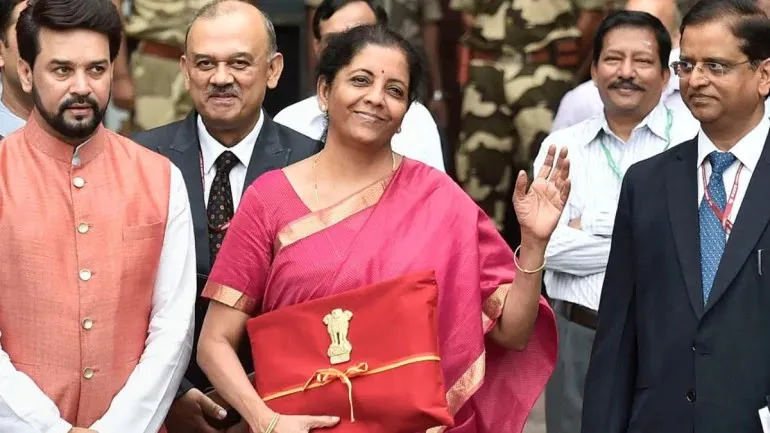Budget 2019 key highlights: Finance Minister Nirmala Sitharaman's maiden Budget puts India on the road to $5 trillion economy in 2025
Finance Minister Nirmala Sitharaman presents her maiden Budget to unlock plans to take the Indian economy to $5 trillion by 2025.

Finance Minister Nirmala Sitharaman eschews the briefcase for the bahi-khata (ledger) in Budget 2019 (Image Credit: PTI)
Finance Minister Nirmala Sitharaman on Friday presented her maiden Budget, with a roadmap for a new India as she presented a plan to unlock Prime Minister Narendra Modi's vision to turn India into $5 trillion economy by 2025.
"We had set the ball rolling for a New India, planned and assisted by the NITI Aayog, a broad based think tank. We have showed by our deeds that the principle 'Reform, Perform, Transform' can succeed," the Finance Minister said as she began her maiden Budget presentation on Friday.
Reiterating Modi's vision to turn India into a $5 trillion economy, India's first full-time woman Finance Minister presented a Budget that focused on investment-led growth and reforms, including transforming rural lives, enhancing ease of direct and indirect taxation, harnessing India's space abilities, strengthening connectivity infrastructure, and boosting the country's entrepreneurial ecosystem.
"From $1.85 trillion in 2014, our economy has reached $ 2.7 trillion in just five years. Hence, it is well within our capacity to reach the $5 trillion in the next few years," she said.
The finance minister made special mention of India Inc and said entrepreneurs are India’s job creators and the wealth creators. She said,
"Before Independence, businesses understood Swadeshi, now they understand Make in India."
Here's a roundup of YourStory's comprehensive coverage of the key announcements from Finance Minister's Budget Speech:
ECONOMY
- Budget 2019 key highlights: Finance Minister Nirmala Sitharaman's maiden Budget puts India on the road to $5 trillion economy in 2025
- Budget 2019: India needs structural reforms to become $5 T economy, says Sitharaman
STARTUPS
- Angel tax: Budget 2019: Relief for startups as Government eases Angel Tax regulations
- Startup channel: Budget 2019: Finance Minister announces exclusive TV channel for startups
TAXES
- Corporates: Budget 2019: Companies with a turnover of up to Rs 400 Cr to be taxed only 25 pc, says Sitharaman
- Super-rich: Budget 2019: Petrol, diesel to be costlier; tax on super-rich, gold imports
EV INDUSTRY
EDUCATION SECTOR
SPACE SECTOR
WOMEN
MSME
Budget 2019 at a glance:
(Infographic source: Indiabudget.gov.in)













Here are the updates from the Finance minister's Budget speech
- BHIM, UPI–QR, AePS and other digital modes can be used to push less cash economy. Business establishment with annual turnover of Rs 30 crore can provide/ make digital business payments without any charges or MDR charges on customers and merchants to be imposed.
- To discourage making business payments in cash, a tax deduction at source (TDS) of two percent is proposed on cash withdrawals exceeding Rs 1 crore annually from a bank account.
- Propose to make PAN and Aadhar interchangeable
- Angel tax: Startup will not come under the scrutiny of Angel Tax. There will no enquiry or verification by Assessment Officer of Income Tax unless there is approval from the supervising officer in terms of funds raised.
- India's ease of doing business ranking jumped up from 172 to 121.
- Startups will not require scrutiny by IT department.
- 25 percent of corporate tax on companies with turnover of Rs 400 crore
- GST on EVs lowered from 12 percent to 5 percent.
- Direct revenue has increased by 78 percent.
- Rs 100 lakh crores for infrastructure over the next five years.
- Propose to consider issuing Aadhaar cards for NRIs with Indian passport after coming to India, instead of them waiting for mandatory 180 days.
- NPAs reduced by over Rs 1 lakh crore.
- Public sector banks to be provided with Rs 70,000 crores to boost capital.
- Women entrepreneurship to be encouraged. Committed to building women-led policy making.
- The government to improve youth skills in technological areas such as Artificial Intelligence, Big Data, Robotics, etc
- The government to improve youth skills in technological areas such as Artifical Intelligence, Big Data, Robotics, etc
- Doordarshan-like TV channels for startups
- In a matter of two years, 300 entrepreneurs emerged as part of the Standup India scheme.
- Government to streamline multiple labour laws.
- India has the potential to become hub of higher education, we will propose 'Study in India' programme to get foreign students to India.
- We will invest widely in agriculture infrastructure; support private entrepreneurship in value addition in agriculture.
- Further opening up of FDI in aviation, media, animation AVGC and insurance to be examined, in consultation with stakeholders; 100% FDI to be permitted for insurance intermediaries.
- 9.6 crore toilets have been constructed in the Swachh Bharat Abhiyan
- Public holding in listed firms may go up to 35% from the current 25%
- We shall go back to basics on one count. Zero budget farming may not be a new thing. Need to replicate innovative model already in place in few places to double farmers income, says FM
- Payment platform for MSMEs to be created.
- Pension benefit to be extended to around 3 crore retail traders and shopkeepers with an annual turnover less than 1.5 crores under Pradhan Mantri Karam Yogi Man Dhan Scheme.
- India's first indigenous payment ecosystem for transport based on National Common Mobility Card was launched PM in March 2019, enabling people to pay multiple types of transport charges.
- Schemes such as BharatMala, Sagarmala and UDAN are bridging rural urban divide and improving our transport infrastructure.
- Large infrastructure can be built on land held by the Central ministries and Central Public Sector Enterprises across the country through an innovative instrument.
- It is high time India become a part of the global financial system.
- Railway infrastructure will need an investment of Rs 50 lakh crores between 2018 and 2030; PPP to be used to unleash faster development and delivery of passenger freight services.
- India will be made a more attractive FDI destination.
- FAME II scheme aims to encourage faster adoption of electric vehicles by right incentives and charging infra
- From $1.85 trillion in 2014, the economy has reached $ 2.7 trillion; we can very well reach $ 5 trillion in the next few years.
(Edited by Tenzin Pema and Dipti Nair)








